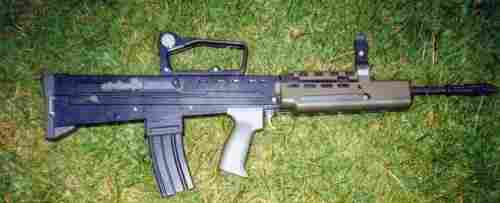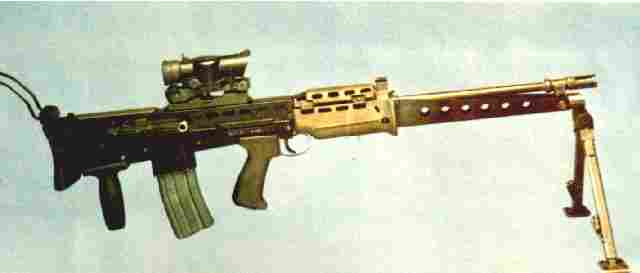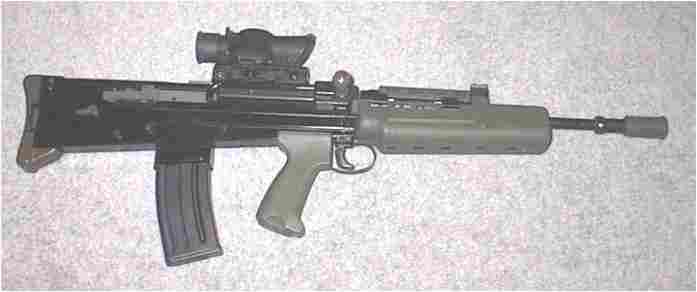|
|
|

After the heyday of the FN FAL, the British Army felt it was about time they had a new general weapon. Somewhere around 1980 a contract was issued to Royal Ordnance to procure a suitable weapon to re-equip all of HM Forces.
The design board of Royal Ordnance came up with a bullpup rifle chambered in .223" Remington (the NATO/US standard small-arms calibre), utilising a 20-round magazine. The bullpup design was unusual in itself as this meant the magazine was behind the pistol grip rather than in front of it.
The stock of the new rifle was to be cast from metal, also it was to be a single-piece unit flush with the body of the rifle. Rather than having an identifiable butt-stock, fore-end and barrel/action, the new rifle was to be essentially a single-piece block. Inside this the action/magazine feeds were to be located, also the fore-end grip was shrouded in plastic. On a military rifle this was a novel feature; plastics of the time weren't generally considered strong enough to withstand a harsh life in the field!
| (above) The early magazine catch (left side of gun). Note the size and lack of a guard |
It was decided early on that, with the new "Americanisation" of anything vaguely military, the new rifle was to become a "weapons system". Associating the word 'system' with 'weapon' gives the mind the impression of something futuristic and advanced, as opposed to yet another variant on a 150-year old concept. In practical terms this meant there would be lots of variants of the new gun.
Royal Ordnance eventually 'named' the rifle the SA80, on the grounds that it was a "...new weapons system for the 1980s". Work began on the production of variants of the weapon. A carbine version with nothing different except a shorter barrel was soon introduced, along with a full-auto only version with a longer barrel and bipod. Open-sight versions also came out, both in light machine gun and rifle versions. A single-shot striaght-pull bolt-action version was also produced as a means of training service cadets on the weapon.
So far, so good. All three Services were re-armed with the new rifle and it performed adequately under standard European conditions of moderate heat, moderate cold, damp and not too much dirt.
Then came the 1991 Gulf War. When removed from its home environment of "everything in moderation", the SA80 series began to show serious faults. In hot, dusty conditions the moving parts soon fouled up with dirt and dust and jammed extremely quickly. The mag drop-out catch caught against soldiers' webbings and often dropped the magazines out, usually at embarassing moments! Most seriously, the troops began to lose faith in their (only) rifle. Jamming actions required the entire gun to be stripped, dismantled, cleaned, oiled and re-assembled, a process which took time and patience. In the middle of a firefight this was a serious handicap.
The military eventually gave the new series of weapons their own "names":
The original rifle became the L85.
The light machine gun (LMG) became the L86A1.
The cadet training version was named the L98A1.
The carbine and open-sight versions retained their original 'parent' designations.
The L85
This was the designation afforded to the initial design. Issued either in open-sight configuration or with the SUSAT, this weapon remains the standard service issue rifle, despite the problems facing it. After a review of the weapon in 2002, which recommended several modifications to improve the design, including re-barreling all 200,000 L85s on general issue, the modified weapons were re-designated the L85A2.
The L86
Essentially the regular L85 with a full-auto action, a longer barrel and a bipod. Royal Ordnance actually put this light support weapon on the general market as a sniper rifle! Why? Because they were too accurate with the long barrels. One can only assume support gunners in HM Forces have been trained to shake it a bit when they fire to impart the necessary "random" hits upon enemy positions. Normally known within the Forces as the LSW, "light support weapon".

The L98
Single-shot straight-pull bolt version of the L85; only issued to cadet units. This weapon is more like the Lee-Enfield in operation due to the straight-pull bolt than any other British service rifle.
A modified version of the L98, with a semi-auto only action, is planned to enter service in a few years' time.
